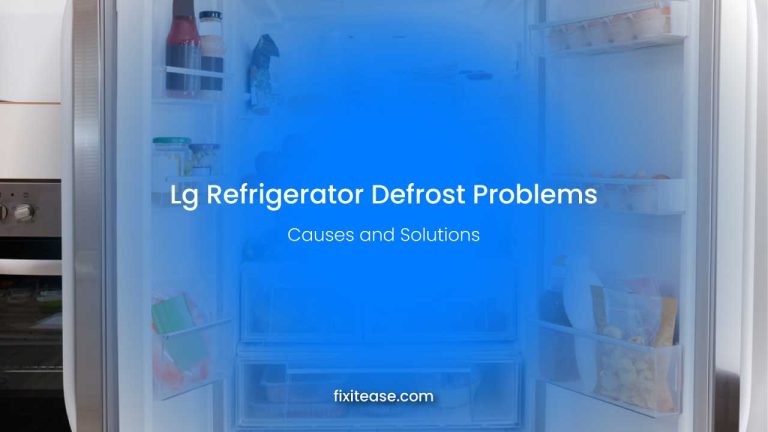5 Common GE Cafe Refrigerator Problems: A Personal Journey
Typical problems with GE Cafe refrigerators encompass challenges with cooling, the ice maker, the freezer, the water dispenser, the control panel, and the compressor. Fortunately, these problems are often solvable; this is where our troubleshooting guide assists.
I recently faced an issue with my own GE Cafe fridge. The temperatCommon Issues with GE Café Refrigeratorsure seemed off, and my ice maker was acting up. It got me thinking: I can’t be the only one. So, I dove into researching and troubleshooting. Turns out, these fridges, as sleek as they are, can have issues with temperature control, the ice maker, water dispensers, and even strange noises.
My journey wasn’t just about fixing a fridge. It was about understanding the quirks of this particular brand. From inconsistent cooling to unresponsive control panels, I’ve seen it all. And guess what? Most of the time, I’ve found ways to fix these issues without calling in a pro. Stick around, and I’ll share what I’ve learned, ensuring your GE Cafe refrigerator runs smoothly, just like mine.
Here is a table summarising the common GE Cafe Refrigerator issues:
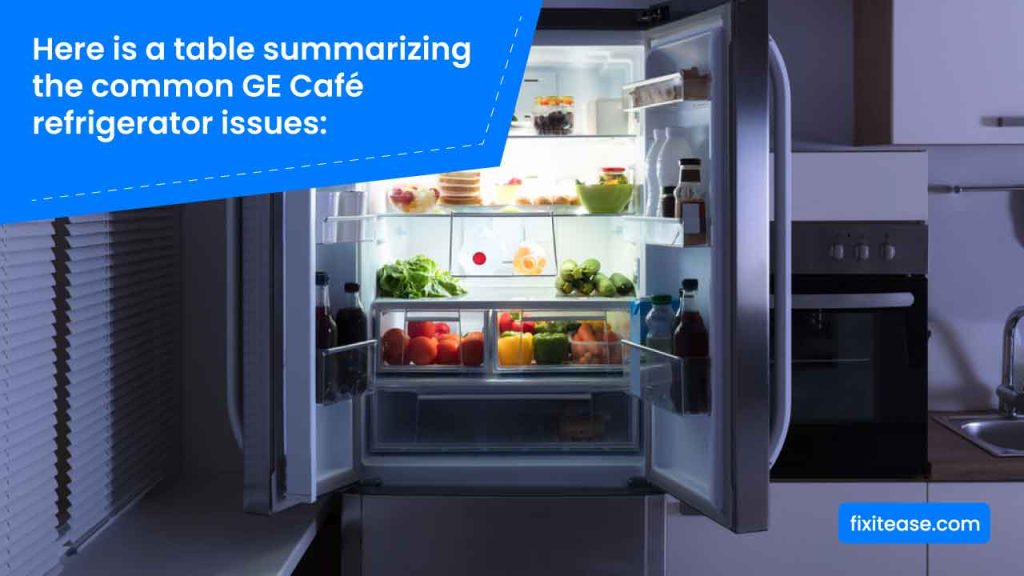
| Issue | Symptoms | Possible Causes | Solutions |
| Not Cooling Properly | Inconsistent temperatures, food spoilage | Faulty thermostat, blocked vents, overstuffing | Adjust thermostat, clear vents, clean coils |
| Ice Maker Not Working | No ice production, small or cloudy ice cubes | Blocked water line, low freezer temperature | Check temperature, reset ice maker, clear water line |
| Water Dispenser Problems | Slow flow, leaks, not cold water | Clogged filter, supply line issues | Replace the filter, check the supply line |
| Strange Noises | Buzzing, knocking, unusual sounds | Unlevel fridge, compressor or fan issues | Level fridge, clean dust from components |
| Control Panel Glitches | Unresponsive, error messages | Electrical glitches, faulty wiring | Reset fridge, check electrical connections |
| Electrical Problems | Fridge is not powering on, flickering lights | Power supply issues, malfunctioning components | Check power source, seek professional help |
Common Issues with GE Cafe Refrigerators
GE Cafe refrigerators are renowned for their sleek design and advanced features, but they’re without quirks. Common issues range from temperature inconsistencies to ice maker malfunctions and even control panel glitches.
As a GE Cafe fridge owner, I’ve encountered a few of these challenges firsthand. I will explore these common problems in detail, helping you understand what to look out for and how to address them effectively.
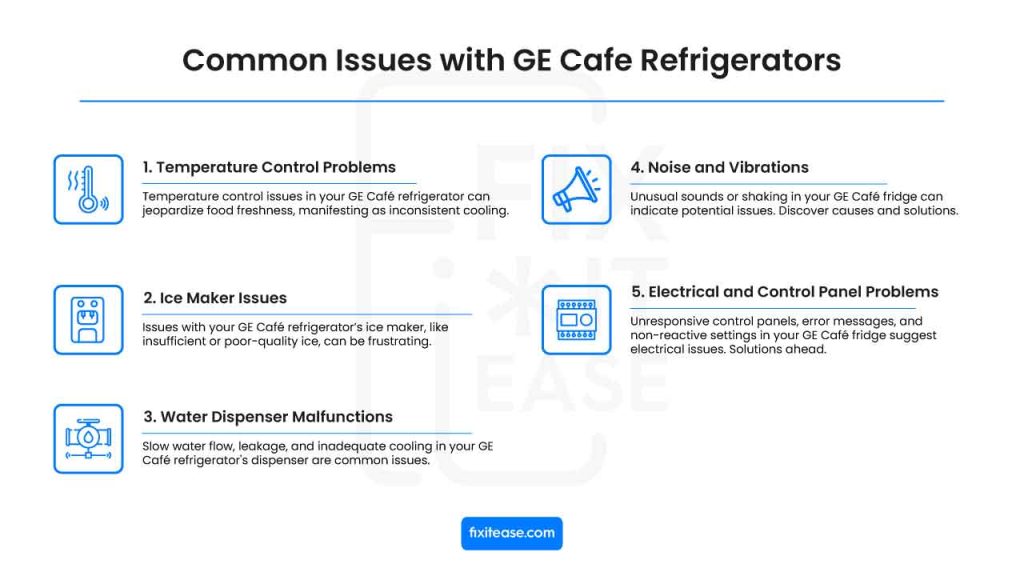
1. Temperature Control Problems
When your GE Cafe refrigerator doesn’t maintain the right temperature, it’s more than an inconvenience; it’s a threat to your food’s freshness and safety. Common temperature control problems include inconsistent cooling, the freezer not freezing adequately, and the fridge section either overcooling or undercooling.
These issues can manifest in various ways, from frozen vegetables in the fridge to soft ice cream in the freezer. Understanding the symptoms, causes, and impacts of these problems is crucial in finding the right solutions to keep your fridge functioning optimally.
Causes
- Inconsistent Cooling: Causes might include a faulty thermostat, clogged air vents, or a malfunctioning defrost system.
- Freezer Not Freezing Adequately: This could be due to frost buildup, a failing freezer fan, or overpacking the freezer.
- Fridge Overcooling/Undercooling: Incorrect thermostat settings, faulty damper, or sensor issues are common culprits.
Impact
- Inconsistent Cooling: This leads to increased energy consumption and poor food preservation.
- Freezer Issues: Food spoilage and higher energy bills due to the freezer working overtime.
- Fridge Temperature Fluctuations: Overcooling can cause food waste and higher energy usage while undercooling risks food safety and spoilage.
Solutions
- For Inconsistent Cooling: Regularly clean and check air vents for blockages, and consider resetting or replacing the thermostat if necessary.
- Addressing Freezer Problems: Defrost your freezer and check for obstructions hindering airflow. Also, ensure it’s not overfilled.
- Correcting Fridge Temperature Issues: Adjust the thermostat settings, check the damper for proper operation, and ensure the sensors function correctly.
2. Ice Maker Issues
Problems with your GE Cafe refrigerator’s ice maker are annoying, especially if you use it daily. You might face issues like the ice maker not making ice, making too little ice, or the ice not looking or tasting good. This could mean finding the ice bin empty when it should be full, getting small ice cubes, or the ice looking cloudy and not fresh. Knowing why these problems happen and how they affect your ice maker is important for fixing them.
Causes
- Non-Functional Ice Maker: This could be due to a water supply issue, a clogged filter, or a malfunction in the ice maker mechanism.
- Low Ice Production: Often results from a partially blocked water line, low freezer temperatures, or a dirty filter.
- Poor Ice Quality: This can be caused by stale water in the line, a need for filter replacement, or impurities in the water supply.
Impact
- Non-Functional Ice Maker: The absence of ice can be inconvenient for daily use and entertaining guests.
- Low Ice Production: Reduces the convenience of having a ready supply of ice and can be problematic during gatherings or in hot weather.
- Poor Ice Quality: This can affect the taste of beverages and might indicate water quality issues.
Solutions
- Fixing a Non-Functional Ice Maker: Check the water supply line for kinks or blockages and replace the water filter if necessary. Also, ensure the freezer is at the correct temperature for ice production.
- Increasing Ice Production: Clean or replace the filter and check the water supply line. Adjust the freezer temperature if it’s too low.
- Improving Ice Quality: Change the water filter regularly and flush the system to remove any stagnant water. If the issue persists, consider testing your home’s water quality.
3. Water Dispenser Malfunctions
You might notice the water trickling slowly, leaking around the dispenser, or not being cold enough. These problems can disrupt your daily routine, especially when you depend on the dispenser for quick access to cold water. Understanding what causes these malfunctions and how to address them is crucial for a hassle-free fix.
Causes
- Inconsistent Water Flow: This might happen if the water line is blocked or if the dispenser’s filter needs changing.
- Water Leakage: Leaks can be caused by loose connections in the water line or a problem in the dispenser system.
- Not Cold Enough: If the water isn’t cold, it could be due to the fridge’s temperature settings or issues with the cooling system.
Impact
- Slow Water Flow: This can be annoying and means it takes longer to fill a glass.
- Leaks: It can cause water to pool around your fridge, which is messy and dangerous if someone slips.
- Warm Water: If the water isn’t cold, it’s not refreshing, which could signal a bigger problem with the fridge’s cooling.
Solutions
- Fixing Slow Water Flow: Check and clean the water line or replace the filter if it’s old.
- Stopping Leaks: Tighten loose connections and check the dispenser for cracks or damage.
- Getting Cold Water: Adjust the fridge’s temperature settings or check if the cooling system needs repair.
4. Noise and Vibrations
Your GE Cafe fridge might start making unusual sounds like buzzing or knocking, or it could shake more than normal. These signs shouldn’t be ignored because they could point to bigger problems. Let’s look at why these things happen and how you can fix them.
Causes
- Unusual Noises: These sounds can be due to various issues, such as a malfunctioning fan, loose components, or a problem with the compressor.
- Excessive Vibration: Often, vibrations occur if the fridge isn’t level or if there’s an issue with the motor or internal components.
Impact
- Noises: Persistent unusual noises can be a sign of wear and tear that, if ignored, might lead to more serious and costly repairs.
- Vibrations: Regular vibrations can be annoying and indicate that your fridge is working harder than it should. It could lead to more energy use and faster wear-out of parts.
Solutions
- Addressing Noises: Check for loose parts and ensure the fridge is properly levelled. If the noise persists, it might be time to look at the fan or compressor.
- Reducing Vibrations: Ensure the fridge is on a flat surface and adjust its feet to level it out. If the vibration continues, it might be an internal mechanical issue needing professional attention.
5. Electrical and Control Panel Problems
The control panel might be unresponsive, showing strange error messages, or the fridge might not react to your settings. These are signs of underlying electrical issues. Let’s explore the causes behind these problems and find out how to fix them.
Causes
- Control Panel Malfunctions: These can be due to electrical glitches, faulty wiring, or software issues within the fridge’s system.
- Display Errors: Errors or blank displays often point to malfunctioning sensors or issues with the refrigerator’s main control board.
- Non-Responsive Refrigerator: This can result from power supply problems or faults in the refrigerator’s electrical components.
Impact
- Control Panel and Display Issues: These can prevent you from using the fridge effectively, making it hard to adjust settings or understand what’s wrong.
- Non-Responsive Behavior: This can lead to food spoilage if the fridge stops cooling properly and can be inconvenient.
Solutions
- Fixing Control Panel Issues: Try resetting the refrigerator or checking for loose connections. If problems persist, the control panel might need professional servicing.
- Resolving Display Errors: Resetting the fridge can sometimes clear these errors. If not, it might indicate a need for technical repair or replacement of the control board.
- Dealing with Non-Responsiveness: Ensure the fridge is properly plugged in and the power supply is stable. A technician might need to check the electrical components if these aren’t the issue.
Troubleshooting and Solutions for GE Cafe Refrigerator Problems
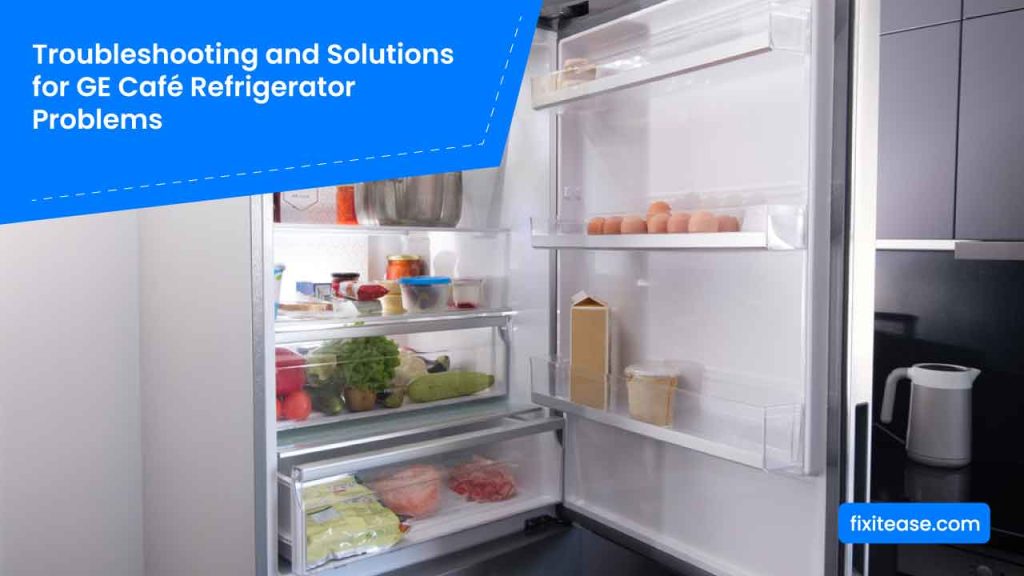
Following these troubleshooting steps and solutions, you can often resolve common issues with your GE Cafe refrigerator, ensuring its longevity and optimal performance.
Adjust the Thermostat
Locate the thermostat control in your fridge and adjust it to the recommended settings. Sometimes, simply resetting the thermostat can resolve issues. Wait for 24 hours to see if the temperature stabilizes after adjustment. Avoid frequent changes as they can cause more fluctuations.
Check for Blocked Vents
Inspect the air vents in the fridge and freezer compartments for blockages. Remove any items that might be obstructing airflow. Regularly organize and clean the fridge to prevent future blockages. Ensure proper circulation for efficient cooling.
Clean and Maintain
Regularly clean the ice maker and water dispenser components. This includes wiping down surfaces and removing any debris or ice build-up. Use a mild detergent and avoid harsh chemicals to prevent component damage.
Check Water Line Connections
Ensure that the water line connections to the fridge are secure and not leaking. Check for kinks or blockages in the line. Regularly inspect these lines for signs of wear and tear and replace them if necessary.
Reset the Ice Maker
Most GE Cafe models have a reset button or procedure for the ice maker. Consult your manual for specific instructions. After resetting, wait 24 hours to see if ice production returns to normal.
Identify the Source of Noise
Listen to determine if the noise comes from the back, bottom, or inside the fridge. This can help pinpoint the issue. Note when the noise occurs (e.g., during cooling cycles) as this can provide clues for troubleshooting.
Basic Electrical Troubleshooting
Check if the fridge is properly plugged in and the outlet is functioning. Look for tripped circuit breakers or blown fuses. Avoid using extension cords as they can cause power fluctuations.
Reset the Control Panel
Follow the manufacturer’s instructions to reset the control panel. This often involves unplugging the fridge for a set period. Be patient and wait for the fridge to reboot before using it again.
Safety Precautions
Always unplug the fridge before inspecting or cleaning electrical parts. Calling a professional is safer if you’re unsure about handling electrical components. If the noise is persistent, unusual, or accompanied by other fridge malfunctions, it’s time to seek professional help.
FAQs
Why is my GE Cafe refrigerator not cooling properly?
Check the thermostat settings and ensure vents are not blocked. Overstuffing the fridge or dirty condenser coils can also affect cooling. If these don’t work, it might be a technical issue like a faulty compressor.
What do I do if my GE Cafe refrigerator’s ice maker stops working?
Ensure the freezer temperature is right, and the water line isn’t blocked. A reset of the ice maker or the fridge might help. If not, it could be a mechanical issue requiring professional repair.
How can I fix water dispenser issues in my GE Cafe refrigerator?
Replace the water filter if it’s old and check for any kinks in the water supply line. Adjust fridge temperature settings if the water isn’t cold enough. Persistent issues may need technical assistance.
My GE Cafe refrigerator is making strange noises. What should I do?
Check the fridge is level and clean dust off the compressor and fans. Persistent or unusual noises like clicking might indicate a serious issue, often needing a technician’s help.
The control panel on my GE Cafe fridge is acting up. How do I fix it?
Try resetting the fridge by unplugging it for a minute. If the panel is still unresponsive or showing errors, it’s likely an electrical issue requiring a professional’s diagnosis.
What are the first steps for troubleshooting electrical problems in my GE Cafe refrigerator?
Make sure the fridge is plugged in, and the power outlet works. Reset any tripped circuit breakers. Contact a professional for safety for complex issues like flickering lights or a dead fridge.
Conclusion
GE Cafe refrigerator issues can feel like a rollercoaster, right? Your fridge has a mind, from those temperamental ice makers to the puzzling temperature swings. But here’s the good news: You’re not alone in this. We’ve all been there, scratching our heads, wondering why our high-end appliance is acting up.
Most of these problems have easy solutions. Whether tweaking the thermostat, unclogging a vent, or resetting that control panel, a little know-how goes a long way. And, if things get too tricky, there’s always professional help just a call away. So, take a deep breath. With the right approach, your GE Cafe fridge will run smoothly again in no time.


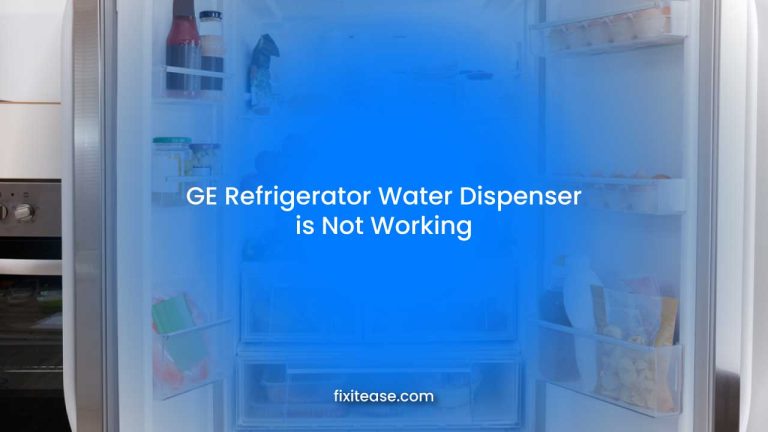
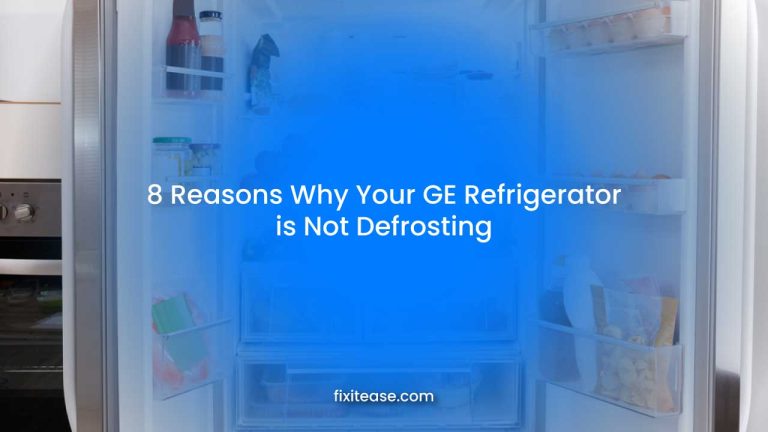

![8 Common GE Refrigerator Problems [With Expert Solutions]](https://fixitease.com/wp-content/uploads/2023/11/Common-GE-Refrigerator-Problems-768x432.jpg)
